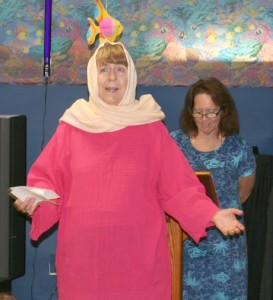What is the real message our Children take home?
 Do you have children at home, or teach a children’s Sunday school class, or lead a Christian youth group? If so, how do you balance the Bible teaching and the entertainment factor in your lesson or family devotions?
Do you have children at home, or teach a children’s Sunday school class, or lead a Christian youth group? If so, how do you balance the Bible teaching and the entertainment factor in your lesson or family devotions?
What is the most important part of a Bible lesson? What gets the greatest proportion of time – the lesson or play-time? Do the games and activities re-enforce the lesson or merely keep the children happy until the bell rings? Do the children go home feeling like the lesson was valuable, or do they think of it as medicine they had to wash down with a spoon full of sugar (fun and games)?
Or, perhaps more telling… do you see the Bible lesson as medicine that must be washed down with fun and games? Do you feel a passion for teaching the Bible?
My heart breaks over churches that place entertainment and keeping everybody happy over their responsibility to teach children to embrace God’s Word. Do we dress up Bible stories so much to make them entertaining – even funny – for the sake of winning the favor of our children, while unwittingly giving them the impression that the Bible isn’t really true – just another collection of fairy tales like Cinderella and Snow White, or tall tales like Paul Bunyan and Johnny Appleseed.
You may not find my opinions expressed in children’s curriculum that is produced by any of the major publishing companies, as they are forced to produce what sells. Thanks to TV based babysitting, and more and more media available for educational purposes, children have been trained to have short attention spans and to have higher expectations of being entertained – as if they are entitled to learn through entertainment without having to make any effort of their own to attain it.
Yet it has been my experience that children are willing to listen to basic Bible stories when they are presented as real-life situations that really happened. It helps to try to think through a Bible story and tell it in a way the child might re-tell it once they knew the story. There is value in using their language and expressions, but it isn’t necessary to fabricate silly details just to make them laugh. Stick to the original story and teach it as real life history. This may be a hard sell for publishers, but it isn’t for children who want to know the truth.
The fun and games are an important part of the lesson, but they need to re-enforce the lesson. Children love to act out stories. There are ways to make learning Bible verses fun. Crafts can fit the stories. You can always find coloring pages available for Bible stories.
When you teach the Bible this down-to-earth way you tell children that you find the Bible to be interesting, and they are more likely to catch your love for it as well. But when we overly embellish the stories, we may unwittingly be telling our children that the Bible is really boring – that it is up to you and me to dress it up and make it palatable.
Find Janice D. Green’s Bible storybooks at Honeycomb Adventures Press, LLC

I completely agree with you Janice!
One way I like to tell the story is to use Betty Lukens Through the Bible in Felt & simply tell the story. After I have told the story I have a craft &/or colouring activity, but I also leave the story board out for the children to retell the story themselves – they love doing this! I have another activity going on at the same time so that the children can each have a turn with a friend retelling the story, & the others can get busy with something else while waiting their turn.
Wendy, you have added an excellent way to tell Bible stories. When I was a school librarian I created a few storyboard activities. With one of them I made paper copies for the children to cut out and use to re-tell the story. We need printable take-home pieces for Bible stories.
I totally agree Janice! In too many children’s programs, entertainment has become the focus. There are many exciting Bible stories that don’t need much more than just the story and someone to tell it.
Thank you Crystal.
Excellent article, Janice. I’m fortunate right now that my kids are older, which allows me to plan multi-week lessons (right now we’re studying the first few chapters of James) and have a meaningful discussion with the kids. I actually don’t have playtime at all.
For VBS this year, every activity or craft tied right in to reinforce the principles being taught. Fun and games are great, but sharing the Truth is much more important.
Thank you Cheryl. Most VBS plans do have activities that are designed to reinforce the lesson. I find it sad when people decide to do something different for convenience.